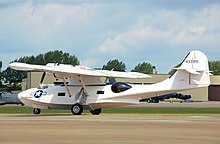Canadian Vickers
Canadian Vickers Limited was a Canadian shipbuilding company. In the 1960s and 1970s, railcars were also manufactured at the shipyard in collaboration with railway companies. After several changes of ownership, the company was dissolved in 1989 and the shipyard was dismantled.
From 1923 to 1944 Canadian Vickers was also active in aircraft construction, which then became the new company Canadair Ltd. which passed into the majority ownership of a US company in 1946 .
history
At the instigation of the Canadian government, the British shipbuilding and armaments group Vickers founded Canadian Vickers Limited in 1911 and built a shipyard in Montreal in which ships for the Royal Canadian Navy , which was to be built, were to be built.
shipbuilding
During the First World War the shipyard built submarines of the type Holland 602 for the Royal Navy (ten H-class boats ), the Russian (6) and the Italian Navy (8). 1918 were minesweepers of various types for the Canadian Navy built. However, the planned further expansion of the Royal Canadian Navy largely ceased after the war.
From the end of the war, the shipyard built a number of cargo ships, but only smaller ships from 1922 to 1941.
For the construction of warships it came at the shipyard again until World War II when she eight corvettes of the Flower-class , six minesweepers of Bangor class , 26 frigates of the River made some class and landing vehicles.
The frigate HMCS Stormont (K327) later became the most famous ship built by Canadian Vickers after being converted into the luxury yacht Christina O for Aristotle Onassis in Germany .
Aircraft construction
Canadian Vickers has been involved in aircraft construction since 1923. Production of Vickers Viking flying boats for the Canadian Air Force began that year . Over four hundred aircraft had been built by 1944, including licensed builds from other manufacturers.
In July 1941, the Canadian government commissioned the company to build the PBV-1 Canso amphibious aircraft , a variant of the Consolidated PBY Catalina flying boat . A new plant at Cartierville Airport in Saint-Laurent, northwest of Montreal, was planned for production. This state-owned factory was built and operated by Canadian Vickers on behalf of the government. A total of over 300 Canso 's were made.
Canadian Vickers withdrew from aircraft construction in 1944. Canada transferred the Cartierville plant on November 4, 1944 to the new company Canadair Limited, which was run by former Canadian Vickers managers. In September 1946, Canadair and the manufacturing facilities became majority owned by the Electric Boat Company , a US company.
Airplanes (own designs)
- Canadian Vickers Vancouver , six two-motor flying boats
- Canadian Vickers Vanessa , prototype
- Canadian Vickers Varuna , eight two-motor flying boats
- Canadian Vickers Vedette , 60 single-engine flying boats
- Canadian Vickers Velos , prototype
- Canadian Vickers Vigil , prototype
- Canadian Vickers Vista , prototype
Airplanes (licensed buildings)
- Vickers Viking IV (six)
- Avro 504 N (13)
- Avro 552 (14)
- Curtiss HS-3L (three)
- Fairchild FC-2 (eleven)
- Fokker Super Universal (15)
- Bellanca Pacemaker (six)
- Northrop Delta (20)
- Supermarine Stranraer (40)
- Canadian Vickers PBV-1 Canso (30)
Development from 1945
Canadian Vickers initially focused on shipbuilding after World War II . From 1955 the frigates HMCS St. Laurent (DDE 205) and Ottawa (DDE 229), in 1958 the HMCS Restigouche (DDE 257) and 1962 the HMCS Mackenzie (DDE 261) were built for the Canadian Navy.
In addition to other civilian ships, the shipyard has also built some icebreakers since 1916, most recently in 1969 the Louis S. St-Laurent (11,345 GT, around 27,000 hp). The icebreaker is the Canadian Coast Guard's largest ship .
In the 1960s, the company worked with railroad companies to produce the vehicles for Montreal's 1966 Metro . This was followed by railcars for local traffic and passenger cars.
The company, most recently MIL Vickers Ltd. was called, was dissolved in 1989 and the shipyard dismantled.



